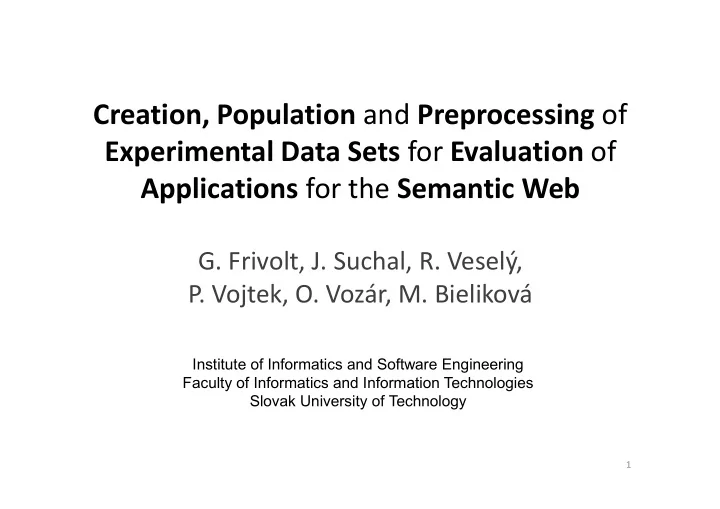

Creation, Population and Preprocessing of Experimental Data Sets for Evaluation of Applications for the Semantic Web G. Frivolt, J. Suchal, R. Veselý, G. Frivolt, J. Suchal, R. Veselý, P. Vojtek, O. Vozár, M. Bieliková ������������������������������������������������� ��������������������������������������������������� ������������������������������� 1
Motivation � Lack of suitable data sets for experimental evaluation of semantic web oriented applications (faceted browser) � Preserve as much as possible information � Preserve as much as possible information from original data sources � Existing data sets miss (or contain sparse) meta-data 2
Goals � Project MAPEKUS 1 � create semantic layer over digital libraries � background for inferencing � analysis of social networks � analysis of social networks � Improve quality of obtained data � identify duplicated and malformed data � Provide visual navigation in data set � ���� !!�������"����"���#�"�� 3
Domain Description � Data from scientific publications domain � Digital libraries: � ACM www.acm.org � Springer www.springer.com � Springer www.springer.com � Meta-data repository: � DBLP www.informatik.uni-trier.de/~ley/db/ 4
Domain Description $������� $��� ������������� 5
Data Process Flow %�������&�������� %��������������� %�������������� ��#���������� ������������������ ���������� ��������'������������������ (��������) �(�*+��) (�������� )� ∪ )� ∪ ∪ � ,� ∪ ∪ � ,� ∪ ∪ � + ∪ � + ∪ ∪ ∪ ∪ ∪ ∪ ∪ ∪ (��������, �(�*+��, (��������+ �(�*+��+ """ 6
Data Process Flow %�������&�������� %��������������� %�������������� ��#���������� ������������������ ���������� ��������'������������������ )+-�(������� )+- �)+-� ∪ �)+-� ∪ ∪ ∪ ∪ � ��������� ∪ ∪ ∪ � ��������� ∪ ∪ ∪ � %,./ ∪ ∪ ∪ ∪ � %,./ ∪ �������� �������� %,./ %,./ 7
Data Process Flow %�������&�������� %��������������� %�������������� ��#���������� ������������������ ���������� ��������'������������������ )+-�(������� )+- �)+-� ∪ �)+-� ∪ ∪ ∪ ∪ � ��������� ∪ ∪ ∪ � ��������� ∪ ∪ ∪ � %,./ ∪ ∪ ∪ � %,./ ∪ ∪ �������� �������� %,./ %,./ ������� �������� ������ 8
Data Acquisition � How did we gather data? � wrapper induction by giving positive and negative examples of patterns on the web pages � Wrapper induction exploits machine learning techniques for generalization of patterns techniques for generalization of patterns � XPath based learning of patterns � generalization of patterns’ attributes using Bayesian networks � Gathered data stored in structured form in an ontological repository 9
Data Acquisition � Wrapped data (depends on data source): � publication instances: name, abstract, year � publication categories, topics and keywords � authorship relation � authorship relation � isReferencedBy and references relations between publications 10
Data Preprocessing � Why to clean data? � inconsistencies: � in source data (name misspelling, diacritics) � inconsistencies created during wrapping process � inconsistencies created during wrapping process � source integration (same author in two sources) – relevant for social networks of authors � Non-invasive cleaning � tagging inconsistent data (without removal) 11
Data Preprocessing Single-pass instance cleaning � Cleaning in the scope of one instance (without relations) � Set of filters, each filter for particular purpose: � correcting capital letters in names and surnames � correcting capital letters in names and surnames � separating first names and surnames � One pass through all instances – linear time complexity 12
Data Preprocessing Duplicate identification � Combination of two methods: � comparison of data properties (e.g., author names, publication titles) � comparison of object properties � comparison of object properties (e.g., coauthors, references, relations between author and publication) 13
Duplicate Identification Data properties comparison � using standard string metrics like � Levenstein distance � Monge-Elkan � N-grams � N-grams � special string metrics � distance of different characters on keyboard � name metrics, considering abbreviations (J. Smyth = John Smyth) 14
Duplicate Identification Object properties comparison � Object properties comparison � for each object property the similarity is computed from number of matches � for example: similarity of two authors depends on � for example: similarity of two authors depends on number of conjoint co-authors 15
Data Process Flow � � %�������&�������� %��������������� %�������������� ��#���������� ������������������ ���������� ��������'������������������ )+-�(������� )+- �)+-� ∪ ∪ ∪ � ��������� ∪ ∪ ∪ � %,./ ∪ ∪ �������� �������� %,./ %,./ 16
Graph Clustering � Graph extraction from ontology � preparation for clustering � Hierarchical clustering � clustering methods from JUNG library � clustering methods from JUNG library � layers generated using bottom-up approach � Results stored in relational database � speed and simplicity 17
ACM visualization (1500 publications) 18
Graph Clustering 19
Graph Clustering 20
Evaluation – Identification of Duplicates � Sampling (publications count) : 1 000, 5 000, 10 000, 20 000 � 10 runs for each sample size � Injected 100 generated duplicities � Injected 100 generated duplicities � All data from DBLP � Duplicities already present in DBLP were ignored 21
Evaluation – Identification of Duplicates 140,00 120,00 ed duplicates 100,00 80,00 Wrong Wrong detected 60,00 Missing Correct 40,00 20,00 0,00 1000 5000 10000 20000 Sample size (number of publications) 22
Evaluation – Identification of Duplicates 0,95 0,90 0,85 % 0,80 0,75 0,70 0,65 1 000 5 000 10 000 20 000 Precision 0,79 0,79 0,81 0,85 Recall 0,90 0,92 0,78 0,77 F1 0,84 0,85 0,80 0,81 23
Evaluation – Identification of Duplicates in Real Data 200 180 160 icate count 140 120 Duplicate ACM ACM 100 100 DBLP 80 Springer 60 Combination 40 20 0 1 000 2 000 3 000 4 000 5 000 Sample size 24
Conclusions � ACM, Springer and DBLP data sources were: � obtained via web scrapping � stored in meta-data preserving format (OWL) � available online: http://mapekus.fiit.stuba.sk � available online: http://mapekus.fiit.stuba.sk � Data evaluation: � data cleaning (duplicity identification) � case study of data set processing – cluster-based visual navigation 25
26
Future Work � Make available integrated and cleaned ontology � add to this “pack” also cluster-based visual navigator of data navigator of data � Create smaller, focused data set in specialized sub-domains for experimental reasons: � software engineering � user modeling 27
���������������������������� ���������������������������� 28
Recommend
More recommend